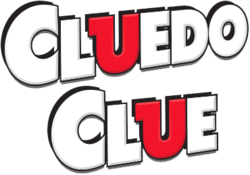| The Classic Mystery Game | |
|---|---|
 The Cluedo and Clue logos (2015–2022) | |
| Designers | Anthony E. Pratt[1] |
| Publishers | Hasbro Waddingtons Parker Brothers Winning Moves Games USA |
| Publication | 1949 |
| Players | 3–6 Players
2–6 Players (editions vary) |
| Setup time | 5 minutes |
| Playing time | 10 to 60 minutes |
| Chance | Low (dice rolling) |
| Age range | 8+ |
| Skills | Deduction |
| Related games | |
| Mysterium, Deception, Scotland Yard | |
| [2] | |
Cluedo (/ˈkluːdoʊ/), known as Clue in North America, is a murder mystery game for three to six players (depending on editions) that was devised in 1943 by British board game designer Anthony E. Pratt. The game was first manufactured by Waddingtons in the United Kingdom in 1949. Since then, it has been relaunched and updated several times, and it is currently owned and published by the American game and toy company Hasbro.
The object of the game is to determine who murdered the game's victim, where the crime took place, and which weapon was used. Each player assumes the role of one of the six suspects and attempts to deduce the correct answer by strategically moving around a game board representing the rooms of a mansion and collecting clues about the circumstances of the murder from the other players.
Numerous games, books, a film, television series, and theatre adaptations have been released as part of the Cluedo franchise. Several spinoffs have been released, featuring various extra characters, weapons, rooms, or a different gameplay. The original game is marketed as the "Classic Detective Game", and the various spinoffs are all distinguished by different slogans.
In 2008, Cluedo: Discover the Secrets was created (with changes to the board, gameplay, and characters) as a modern spin-off, but was criticised in the media and by fans of the original game. Cluedo: The Classic Mystery Game was then introduced in 2012, returning to Pratt's classic formula but also adding several variations.
- ^ Lockley, Mike (17 February 2013). "Plaque to be erected for Kings Heath Cluedo inventor Anthony Pratt". Birmingham Mail.
- ^ Goodridge, Michelle; Rohweder, Matthew J. (15 November 2021). Librarian's Guide to Games and Gamers: From Collection Development to Advisory Services. Bloomsbury Publishing. ISBN 9798216110958.